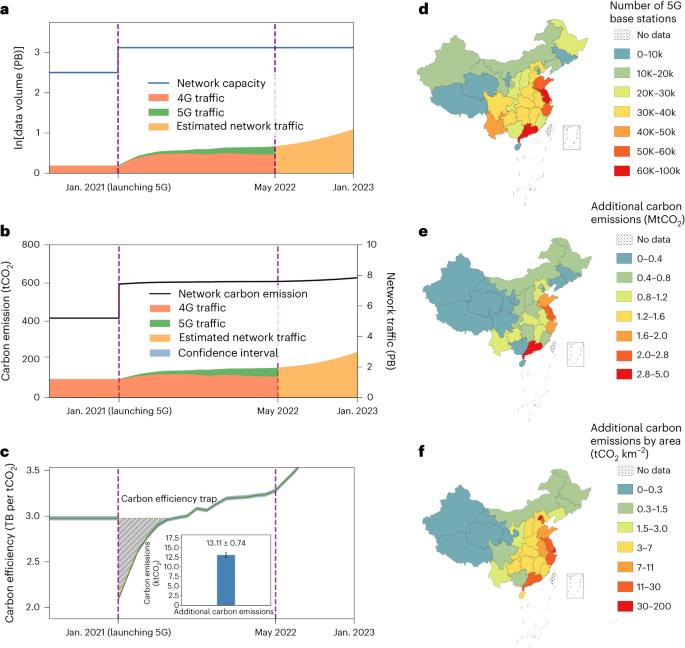中国5G移动网络的碳排放
IF 25.7
1区 环境科学与生态学
Q1 ENVIRONMENTAL SCIENCES
引用次数: 0
摘要
使用 5G 的电信在我们的日常生活和全球经济中发挥着至关重要的作用。然而,5G 移动网络的能耗和碳排放令人担忧。在此,我们开发了一个大规模数据驱动的框架,以定量评估中国 5G 移动网络的碳排放,全球 60% 以上的 5G 基站都在中国建设。我们揭示了 5G 移动网络的碳效率陷阱,它导致中国的额外碳排放量达到 23.82 ± 1.07 兆吨,这是由移动网络中蜂窝流量与能耗之间的时空错位造成的。针对这一问题,我们提出了一种名为DeepEnergy的节能方法,利用协同深度强化学习和图神经网络,可以有效协调5G小区的工作状态,帮助中国超过71%的省份避免碳效率陷阱。到 2023 年,DeepEnergy 的应用可在全国范围内减少 20.90±0.98 兆吨碳排放。此外,通过将 DeepEnergy 与太阳能系统集成,中国移动网络可实现 50% 以上的净零排放目标。我们的研究深化了对 5G 网络碳减排的认识,为实现可持续和高能效的电信基础设施铺平了道路。我们的日常生活和经济活动越来越依赖于 5G 移动网络,但其碳排放却令人担忧。作者在此量化了中国 5G 移动网络的碳排放,并提出了减少碳排放的策略,为实现可持续的移动通信基础设施铺平了道路。本文章由计算机程序翻译,如有差异,请以英文原文为准。

Carbon emissions of 5G mobile networks in China
Telecommunication using 5G plays a vital role in our daily lives and the global economy. However, the energy consumption and carbon emissions of 5G mobile networks are concerning. Here we develop a large-scale data-driven framework to quantitatively assess the carbon emissions of 5G mobile networks in China, where over 60% of the global 5G base stations are implemented. We reveal a carbon efficiency trap of 5G mobile networks leading to additional carbon emissions of 23.82 ± 1.07 Mt in China, caused by the spatiotemporal misalignment between cellular traffic and energy consumption in mobile networks. To address this problem, we propose an energy-saving method, called DeepEnergy, leveraging collaborative deep reinforcement learning and graph neural networks, to make it possible to effectively coordinate the working state of 5G cells, which could help over 71% of Chinese provinces avoid carbon efficiency traps. The application of DeepEnergy can potentially reduce carbon emissions by 20.90 ± 0.98 Mt at the national level in 2023. Furthermore, the mobile network in China could accomplish more than 50% of its net-zero goal by integrating DeepEnergy with solar energy systems. Our study deepens the insights into carbon emission mitigation in 5G networks, paving the way towards sustainable and energy-efficient telecommunication infrastructures. Our daily lives and economic activities increasingly rely on 5G mobile networks, but their carbon emissions are concerning. Here the authors quantify the carbon emissions of 5G mobile networks in China and propose a strategy to reduce them, paving the way to sustainable mobile communication infrastructures.
求助全文
通过发布文献求助,成功后即可免费获取论文全文。
去求助
来源期刊

Nature Sustainability
Energy-Renewable Energy, Sustainability and the Environment
CiteScore
41.90
自引率
1.10%
发文量
159
期刊介绍:
Nature Sustainability aims to facilitate cross-disciplinary dialogues and bring together research fields that contribute to understanding how we organize our lives in a finite world and the impacts of our actions.
Nature Sustainability will not only publish fundamental research but also significant investigations into policies and solutions for ensuring human well-being now and in the future.Its ultimate goal is to address the greatest challenges of our time.
 求助内容:
求助内容: 应助结果提醒方式:
应助结果提醒方式:


